Aug 05, 2005
Mnemonic devices may help brain-injured patients
Mnemonics are devices that allows for classification, organization, storage and recollection of information into and out of long-term memory. In Ancient Rome, orators used mnemonics to remember the points they wanted to make in a speech. The method of remembering they used is called the Method of Loci, invented by the Greek poet Simonides about 500 B.C. Simonides was asked to recite a poem at a banquet, given by one of his patrons, and after doing so the room fell in, burying all in its debris, and disfiguring the bodies so as to render identification impossible. Simonides, however, had noted the position each guest had occupied, and was thus able to point out the remains of each. (A.E. Middleton, All About Mnemonics, London, 1885).
Modern neurosciences have showed that effectiveness of visual imagery mnemonics like Method of Loci is based on the human capability to remember objects when they are placed in a visual structured context. The literature on the use of visual imagery as a mnemonic device has consistently shown that subjects who use visual imagery to help them learn verbal material do considerably better than subjects who attempt to learn the material using simple rote repetition. Brain imaging research has shown that when visual imagery is used to learn verbal material, subjects show brain activity in systems normally involved in processing visual stimuli. The implications of these findings point to the potential learning advantage of a complex imagination.
There is clinical evidence that visual imagery mnemonics are particularly useful in remediation of memory disorders in brain-damaged patients. In particular, research suggests that such techniques can lead to improved performance on formal testing in a number of neurologic disease populations and following lesions of either the left or right hemisphere.
More to explore
Yates, F. (1966) The Art of Memory, Chicago University of Chicago Press
Richardson, J.T. (1992). Imagery mnemonics and memory remediation. Neurology 42 (2):283-286
Medical Mnemonics - A free, non-profit, online searchable database of medical mnemonics to help remember the important details
20:40 Posted in Brain training & cognitive enhancement | Permalink | Comments (0) | Tags: Positive Technology, Cognitive prosthetics
2006 South African Conference on Positive Psychology
2006 South African Conference on Positive Psychology will be taking place in April of next year. The aim of the conference is to provide an update on theory, measurement and application in the domain of positive psychology in general, and in particular as pertains individual, social and work wellness in a multi-cultural context.
Key Information about the conference can be found here
19:01 Posted in Positive Technology events | Permalink | Comments (0) | Tags: Positive Technology
Does technology make us happy?
As designers and social innovators, should we take any notice of technology policy? Wouldn't it be best to ignore the think-tanks and telcos, and concentrate on doing great projects in the real world? A 90% focus on projects would probably be healthy. But we also need to keep half an eye on policy making because that's where priorities for research spending - and hence the projects we are able to do - are made.
Tech policy is not a pretty picture right now. After a few years in which social issues were visible on the agenda, tech-push is fighting back. In the European Union, for example, the Information Society Technologies (IST) programme contains a lot of tech but not much soc. The IST's aim is to 'master technology and its applications, and help strengthen industrial competitiveness'. Documents mention the need to 'address the main European societal challenges' - but the advisory group that interprets that statement, ISTAG, consists wholly of Big Tech and Big Research interests. (To compound the imbalance, ISTAG comprises 29 men and just four women). There once existed a panel of High-Level Socio-Economic Experts but they quietly disappeared in 2003, supplanted by an entity called eEurope. The main job of eEurope is to 'develop modern public services and a dynamic environment for e-business through widespread availability of broadband access at competitive prices and a secure information infrastructure'. Once again: a lot about tech and not much about soc. >>MORE
17:35 Posted in Emotional computing | Permalink | Comments (0) | Tags: Positive Technology, Emotional technology
Aug 03, 2005
Downloading video from the brain
Using cats selected for their sharp vision, in 1999 Garret Stanley and his team recorded signals from a total of 177 cells in the lateral geniculate nucleus - a part of the brain's thalamus (the thalamus integrates all of the brains sensory input and forms the base of the seven-layered thalamocortical loop with the six layered neocortex) - as they played 16 second digitized (64 by 64 pixels) movies of indoor and outdoor scenes.
 Using simple mathematical filters, Dr. Stanley and his colleagues decoded the signals to generate movies of what the cats actually saw. This finding has enormous implications in the fields of neurorehabilitation and neural repair. For example, it could allow to wire artificial limbs directly into the brain, or to develop artificial brain extensions.
Using simple mathematical filters, Dr. Stanley and his colleagues decoded the signals to generate movies of what the cats actually saw. This finding has enormous implications in the fields of neurorehabilitation and neural repair. For example, it could allow to wire artificial limbs directly into the brain, or to develop artificial brain extensions.
More to explore
Garrett B. Stanley, Fei F. Li, and Yang Dan, Reconstruction of Natural Scenes from Ensemble Responses in the Lateral Geniculate Nucleus. Journal of Neuroscience, 1999; 19: 8036 - 8042 Link to the full-text PDF
20:10 Posted in Brain-computer interface | Permalink | Comments (0) | Tags: Positive Technology, brain-computer interface
You can walk and there is no limit
Via the Presence-L Listserv
(From The Seattle Times)
Christina Siderius, Monday, July 25, 2005
Walk in cyberspace: With virtual-reality software, users feel like they're moving even if they're actually sitting on the couch. VirtuSphere wanted to create a device that would allow the user to move limitlessly while using such software — without bumping into walls or falling over. The solution: VirtuSphere, founded in November, created a giant hollow ball that works like a spinning hamster wheel.
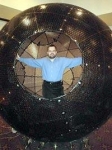 Wearing a head-mounted display, a user can step inside the 8.5-foot-tall sphere and experience physical movements while the mind is in cyberspace. "The purpose is to enable natural motion," said Palladin. "You can walk and there is no limit."
Wearing a head-mounted display, a user can step inside the 8.5-foot-tall sphere and experience physical movements while the mind is in cyberspace. "The purpose is to enable natural motion," said Palladin. "You can walk and there is no limit."
How it works: As the user moves, the ball rolls, sending coordinates to a computer. The computer evaluates the information and relays it back to the user's display in the form of a changed view. The sphere, which costs between $50,000 and $100,000, can be made compatible with any computer-based simulations.. READ THE FULL ARTICLE
19:20 Posted in Cybertherapy | Permalink | Comments (0) | Tags: Positive Technology, virtual reality
Tim Hawkinson's presence-evoking art
Via the Presence-L Listserv
By Christopher Knight, Times Staff Writer
For his mid-career survey exhibition at the Los Angeles County Museum of Art, Tim Hawkinson has suspended wires and electrical cords high overhead throughout the capacious ground-floor galleries of the Anderson Building. The wiring is there to provide power for the machinery and computers that operate his often kinetic art. Think of it as a homemade power grid — a replica in miniature of something vast on which we all rely but about which we pay little attention until it's not there. 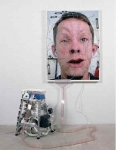 Hawkinson's art is sort of like that too. As a garage band is to a philharmonic orchestra, so Hawkinson's technological tinkering is to science and industry. His art speaks to social experience and human mortality. But part of the work's attraction is the way it peels back its systems of operation like layers of an onion, displaying them for your contemplation.
Hawkinson's art is sort of like that too. As a garage band is to a philharmonic orchestra, so Hawkinson's technological tinkering is to science and industry. His art speaks to social experience and human mortality. But part of the work's attraction is the way it peels back its systems of operation like layers of an onion, displaying them for your contemplation.
Take "Emoter," a self-portrait of the artist as a young cyborg. A cut-up inkjet print showing the artist's face is mounted on a panel of plastic and foam core, which hangs on the wall. Electrodes fastened to the face are connected to mechanical components, mounted like a high school science project on a nearby stepladder. There, light sensors are affixed to a television monitor, and they send random signals in response to the broadcast program.
Walk up to Hawkinson's portrait and, accompanied by soft buzzing and whirring, his face begins to change expressions. Eyebrows rise. Nostrils flare. Lips part. Some expressions are familiar, some freakish.
 While you're puzzling over the portrait's apparent reaction to your presence in the room, and how the goofy effect is accomplished, it suddenly dawns that grins, a furrowed brow and other bemused expressions are washing over your own face too. Who's the real "emoter" here? Hawkinson or his audience?
While you're puzzling over the portrait's apparent reaction to your presence in the room, and how the goofy effect is accomplished, it suddenly dawns that grins, a furrowed brow and other bemused expressions are washing over your own face too. Who's the real "emoter" here? Hawkinson or his audience?
Who is responding to what — the picture to you or you to the picture? Is the title a pun for e-motor — that is, an electronic motor, which reacts mechanically to outside stimuli? Does the flickering TV tube reside at the heart of this emotional circuitry? How mechanical (or preprogrammed) are our own responses to experience?
"Emoter" also puts you in mind of multi-user computer programs, the kind that run over the Internet and allow multiple users to participate in role-playing games. In virtual reality, "to emote" is to indicate the performance of an action, usually with a facial expression of emotional state. Hawkinson's theatrical self-portrait represents the face of a new world — familiar and freakish, but one we all now inhabit... READ THE FULL ARTICLE
More to explore
Tim Hawkinson's interview and works
Art:21 Film on Tim Hawkinson
Tim Hawkinson essay and images
Tim Hawkinson art books (Amazon)
19:11 Posted in Cyberart | Permalink | Comments (0) | Tags: Positive Technology
Jul 28, 2005
IPod induces allucinations?
Via Mind Hacks
Psychiatrist Victor Aziz has suggested that some iPod users are experiencing musical hallucinations owing to the constant repetition of favourite songs.
Dr Aziz was recently featured in a New York Times article discussing musical hallucinations. This story was touted as 'brain becomes an iPod' because musical hallucinations can take the form of complete songs or melodies.
 In an interesting twist, however, Aziz suggests the use of personal music players may lead to musical hallucinations in some people.
In an interesting twist, however, Aziz suggests the use of personal music players may lead to musical hallucinations in some people.
This is not as far fetched as it sounds. A recent brain scanning study used a technique where songs were silenced for short intervals when played, and showed that the auditory cortex remained active when people continued 'hearing' the silenced tune.
The constant repetition of the same music may produce a similar effect, perhaps leading to the hallucinations.
In July's issue of the International Journal of Geriatric Psychiatry Aziz and colleague Nick Warner reviewed 30 cases of musical hallucinations in older people and found the hallucinations could be very specific and distinct:
The hymn 'Abide with me' was clearly the most frequent music heard. In 2/3 of cases religious music predominated, with Christmas music also common. In most cases the music took the form of solo voice (male or female) with instrumental backing. Two people could identify the singer (George Formby and Luciano Pavarotti).
16:45 | Permalink | Comments (0) | Tags: Positive Technology
Jul 27, 2005
Workshop on Personalisation for e-Health
Via Psychnology
Workshop on Personalisation for e-Health to be held in conjunction with UM 2005 Edinburgh, UK, July 2005
The past years have witnessed unprecedented levels of investment in the e-Health sector, both in terms of research effort, and in terms of funding, as well as a great public interest. e-Health can be broadly defined as the application of IT (especially Internet technologies) to improve the access, efficiency, effectiveness and quality of any processes (clinical and business alike) related to health care. In the e-Health vision, intelligent systems would, for example, enable:
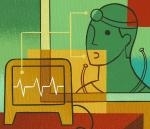 - citizens to take more control of their well-being, by accessing personalised and qualified health information, both medical and pedagogical, and accessing appropriate medical care from their homes;
- citizens to take more control of their well-being, by accessing personalised and qualified health information, both medical and pedagogical, and accessing appropriate medical care from their homes;
- health professionals to manage their activity more efficiently, by receiving relevant and timely updates; and
- teams of health professionals to work together more effectively, coordinating their activities, sharing their knowledge about the patients they are collectively taking care of, and ensuring the best coordinated care is provided.
17:35 Posted in Positive Technology events | Permalink | Comments (0) | Tags: Positive Technology
CHI 2005 - Student Design Competition Results
Via CHI 2005 web site
Computer Human Interaction 2005 Student Design Competition challenged students to design a tool, application or service for elder companionship. The winning team was mPath (Shweta Aneja, Kevin Makice, Apurva Pangam, Matt Weldon, Indiana University, USA). mPath works with administrators of assisted-living facilities to oversee an ad-hoc volunteer network. Interacting with residents, these volunteers assess social relationships and emotional reactions, quantifying for the computer their qualitative observations. In turn, the system examines data over time to isolate anomalies, highlight trends and anticipate future responses. Administrators act upon that information. The overall effect is to increase the social well being of seniors in an unobtrusive manner.
17:15 Posted in Positive Technology events | Permalink | Comments (0) | Tags: Positive Technology
Ambient Experience for children undergoing MRI scan
Via Near Near Future
Ambient Experience for Healthcare is a program designed to lessen patient anxiety and claustrophobic effects of an MRI scan through the use of a multimedia environment. As soon as patients enter the MRI department, they are automatically identified by the system and the environment changes to match their personal features. Lighting and ambience of the room, as well as music and projections, can be adapted to match the specific needs of patients.

Patients can choose from four themes, each geared for different tastes and age groups; aquatic, space, fly-through and a default lava lamp type ambience. RFID-encoded cards corresponding to the theme chosen by patients cause the lighting and wall/ceiling projection to change in the exam room as they enter.
Ambient Experience was recently awarded a gold medal in the annual Industrial Design Excellence Award
10:45 Posted in Pervasive computing | Permalink | Comments (0) | Tags: Positive Technology, Ambient intelligence
Jul 26, 2005
Faculty psychologist job position at Emory using VR
Via VRPsych list
Faculty Psychologist - Emory University School of Medicine, Department of Psychiatry and Behavioral Sciences announces a full time assistant professor position. Job duties include working on an NIMH-funded study exploring medication and virtual reality exposure therapy, administering CBT, program development, and supervision. Requirements: doctoral degree, APA approved internship, CBT experience, supervised postdoctoral year, and Georgia licensed or license eligible.
Application deadline 9/1/05 or until filled.
Send CV, letter of interest, publications, and 4 letters of recommendation to Barbara O. Rothbaum, Ph.D., ABPP, Psychiatry, The Emory Clinic, 1365 Clifton Rd, Atlanta, GA 30322.
17:10 Posted in Research institutions & funding opportunities | Permalink | Comments (0) | Tags: Positive Technology, research tools
Jul 25, 2005
Affective computing in healthcare: the project Myself
The EU-funded project Myself focuses on the enrichment of the simulations and the affective computing methodologies traditionally carried out in didactic classroom.
The project's idea is to integrate affective computing into virtual tutors to enhance distance learning and training applications. Affective computing is aimed at giving computers skills of emotional intelligence, including the ability to recognize and express emotions, and to respond to them effectively.
Started in Semptember 2004 and running 24 months, the project gathers industries and research performers from seven European countries (Italy, Spain, United Kingdom, Estonia, Switzerland, Poland, Holland). The project's coordinator is ACSE, an Italian company that supplies information technology services.
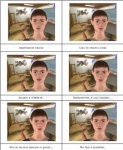 We have interviewed Dr. Fabrizia Mantovani, psychologist, who is working on the research workpackage on Affective Computing for the Center for Studies in Communication Sciences of University Milano-Bicocca, headed by Prof. Luigi Anolli.
We have interviewed Dr. Fabrizia Mantovani, psychologist, who is working on the research workpackage on Affective Computing for the Center for Studies in Communication Sciences of University Milano-Bicocca, headed by Prof. Luigi Anolli.
PTJ - Dr. Mantovani, what are the potential applications of Myself project?
The target application of the project was the development of an e-learning platform endowed with affective computing capabilities (recognition of, and adaptation to, the emotional and motivational states of the users during the learning path). The second objective is development of interactive simulations for the training of communication and emotional skills in professional relationships. In this project, two main target-end users are finance and banking and healthcare professionals.
PTJ - Interesting. But how this approach can be used in healthcare?
The idea is to use 3D-agents based simulations to train physicians and caregivers on how to improve the relationships with patients and their families. Traditionally, soft-skill training is mainly carried out in classroom and face-to-face settings. In Myself, the goal is to use experiential e-learning training to support the acquisition of complex communication and procedural skills (i.e. how to deliver bad health news to the patient, enhance compliance, to be in trust in the relationship etc.), which are useful to improve the relationship between doctors and patients.
More to explore
Affective Computing Portal - a web site devoted to affective computing research
Affective Computing Lab at MIT Medialab - web site of the lab headed by Rosalind Picard
Virtual Reality Lab (VRlab) at the Swiss Federal Institute of Technology - the leading lab for virtual humans research
12:00 Posted in Emotional computing | Permalink | Comments (0) | Tags: Positive Technology, experience computing
Jul 24, 2005
Siggraph 2005
The 32th Conference on Computer Graphics and Interactive Techniques Siggraph 2005 will be held in Los Angeles, 21 July - 4 August. This year advanced program can be downloaded here.
Unfortunately this year I am not going to attend the conference, but if I would, I could not miss Emerging Technologies. The event, hosted by the Siggraph Conference, presents work from many sub-disciplines of interactive techniques, with a special emphasis on projects that explore science, high-resolution digital-cinema technologies, and interactive art-science narrative.
An ET application I would love to see is Haptic Video, presented by Satoshi Saga and colleagues from Tachi Laboratory, The University of Tokyo. Haptic Video allows to transmit physical operations with the same precision, they say, as language.  "In the recording phase", explain Saga, "position and applied force are recorded as the expert works. This information is transformed into position and impedance information, and archived in a database that can be dynamically interpolated. In the presentation phase, the impedance information is presented to the trainee along the trajectory direction, and virtual fixtures, which are like walls with elasticity, are presented orthogonal to the trajectory direction at the same time. As a result, the trainee tries to cancel the force that the expert exerted, and duplicate the desired force proactively"
"In the recording phase", explain Saga, "position and applied force are recorded as the expert works. This information is transformed into position and impedance information, and archived in a database that can be dynamically interpolated. In the presentation phase, the impedance information is presented to the trainee along the trajectory direction, and virtual fixtures, which are like walls with elasticity, are presented orthogonal to the trajectory direction at the same time. As a result, the trainee tries to cancel the force that the expert exerted, and duplicate the desired force proactively"
According to the researchers, Haptic Video demonstrates how humans can use technology to improve their skills in a wide variety of professional and aesthetic fields, from medicine to calligraphy to etiquette.
I also believe that Haptic Video meets all the requirements of a Positive Technology. I foresee applications of this new technology in the field of healthcare, i.e. in distance rehabilitation and telemedicine.
So good luck to Haptic Video
20:20 Posted in Positive Technology events | Permalink | Comments (0) | Tags: Positive Technology
Jul 22, 2005
Mixed and Augmented Reality Conference
The 4th IEEE and ACM International Symposium on Mixed and Augmented Reality (ISMAR 05) will be held from October 5-8, 2005, in Vienna, Austria. Sponsored by IEEE Computer Society and the Österreichische Akademie der Wissenschaften, the conference covers latest developments in the fields of augmented and virtual reality. Over the last decade, these technologies have evolved from experimental technologies to mainstream research activities that are starting to show impact on industry and society. By their very nature, Mixed Reality and Augmented Reality are highly interdisciplinary fields involving signal processing, computer vision, computer graphics, user interfaces, human factors, wearable computing, mobile computing, computer networks, distributed computing, information access, information visualization, and hardware design for new displays and sensors.
16:38 Posted in Positive Technology events | Permalink | Comments (0) | Tags: Positive Technology
Smart brace to prevent falls in the elderly
Via Medgadget and Near Near Future
Stanford entrepreneurs are testing a "smart" brace to prevent falls in the elderly. The tool is fitted with a tiny chip, which continuously monitors the position of the ankle. If the chip detects a roll that is greater than normal, it begins to vibrate. 
The vibrations send a signal to the brain that the person needs to change the position of their foot or shift their balance in order to avoid a fall.
More to explore:
12:25 Posted in Brain training & cognitive enhancement | Permalink | Comments (0) | Tags: Positive Technology, Cognitive prosthetics
Jul 21, 2005
Ubiquitous computing for cognitive decline
Cognitive decline is one of the most taxing health problems in terms of both its relation to elders' overall functioning and the cost of care. The loss of their abilities to use everything from a coffee maker to a computer may lead to social isolation, a decreased motivation, and increasing dependence on skilled support for assistance in routine activities. Prevention, early detection, and assistance for cognitive decline may be a useful application for ubiquitous computing technologies.
Ubicomp solutions typically involve multiple invisible devices embedded in the physical environment, all connected together to respond in transparent ways to the users in the context of everyday events. Ubicomp may match the challenge of providing elders pervasive support throughout the home, and adaptable levels of support.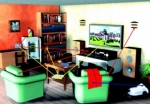
For example, Intel's Proactive Health Research initiative is exploring location and activity tracking technologies to support elders' indipendence and safety monitoring by caregivers. The programme also aims at investigating technologies that facilitate social connectedness and continuation of meaningful activities.
More to explore
Free full-text publications on pervasive computing
16:05 Posted in Pervasive computing | Permalink | Comments (0) | Tags: Positive Technology, Ambient intelligence
VR is going to be cheap
Virtual Reality Therapy (VRT) offers treatment using simulated real life experience provided in a confidential setting. VRT has shown its effectiveness in several common phobias, including claustrophobia, fear of heights, fear of spiders, fear of driving, fear of flying, and fear of public speaking. As a person goes through the VR program, the therapist teaches the client relaxation techniques to deal with the symptoms provoked by exposure to the virtual environment.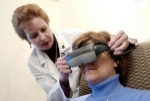
However, until recently, the use of VRT was severely limited by the lack of inexpensive immersive equipment. This opportunity could come along in the fourth quarter of this year, when 3001AD, a company that builds high-end VR machines for large-scale entertainment centers, will introduce a headset that can be used in combination with the Xbox and the Playstation game consoles and several blockbuster game titles.  The system, called "Trimersion" and recently demonstrated at the E3 trade show, promises 360-degree head tracking, uses a binocular video subsystem and delivers a QVGA resolution (320 x 240). Mark Rifkin, senior vice president of 3001 AD suggested retail pricing to come in just under $500.
The system, called "Trimersion" and recently demonstrated at the E3 trade show, promises 360-degree head tracking, uses a binocular video subsystem and delivers a QVGA resolution (320 x 240). Mark Rifkin, senior vice president of 3001 AD suggested retail pricing to come in just under $500.
More to explore:
Cybertherapy.info the reference site for VR therapy
Virtual reality in behavioral neuroscience and beyond, Nature Neuroscience, 1089-1092, Oct. 2002
Virtual Reality Therapy, Harvard Mental Health Letter, on-line, April 2003
Fake worlds offer real medicine, Journal of the American Medical Association, 290 (10), 2107-2109, 22/29 Oct 2003
15:15 Posted in Cybertherapy | Permalink | Comments (0) | Tags: Positive Technology, virtual reality
Jul 19, 2005
The Fifth International Conference on Gerontechnology
The fifth international conference on Gerontechnology took place in Nagoya May 24-27 2005. The slogan of the conference was "Technology for smart aging - For a long and happy life with health and self-esteem". The conference program included sessions like Universal Design, Mobility, Home care and Living, Health care and Robotics for Human Support. Topics like Work and Leisure were also treated.
Use of new information technology (IT) solutions was taken up in most of the presentations. The goal could be to provide elderly people with information about preventive care, help them get useful information when moving around outdoors or handling activities of daily living. It was shown that IT and Assistive Technology (AT) could be used to counteract the triggering factors that normally result in hospitalisation and long time care.
The Design for All and Inclusive design approaches were constantly referred to because it was shown that the elderly people had to be able to use new technology and services themselves. Use of Design for All or Inclusive design strategies and methods ensure that mainstream products, services and environments are accessible to the largest number of people.
Organiser of the conference was the International Society for Gerontechnology ISG.
More to explore:
Links to the conference abstracts:sts.bwk.tue.nl/gerontech/Full_text/Volume_3/nr_4/Contents...
12:32 Posted in Positive Technology events | Permalink | Comments (0) | Tags: Positive Technology
Vagus Nerve Stimulation System for Severe Depression
Via Medgadget
The Food and Drug Administration has recently approved a new treatment for severe depression based on a nerve stimulation system that delivers tiny electric shocks through vagus nerve and into a region of the brain thought to play a role in mood.
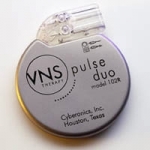 Cyberonics Inc.'s stimulation system is an adjunctive long-term treatment of chronic or recurrent depression for adults who are experiencing a major depressive episode that has not had an adequate response to two or more adequate antidepressant treatments.
Cyberonics Inc.'s stimulation system is an adjunctive long-term treatment of chronic or recurrent depression for adults who are experiencing a major depressive episode that has not had an adequate response to two or more adequate antidepressant treatments.
Despite controversy over whether it's really been proven to work, the potential treatment targets an estimated 4 million Americans with hard-to-treat depression.
12:00 Posted in Brain-computer interface | Permalink | Comments (0) | Tags: Positive Technology, brain-computer interface
Wearable technology promotes the well-being of the elderly
A Finnish IST International Security Technology has developed a well-being wristband called Vivago™, which analyses and transmits information on the user's level of activity and notifies if any deviations from normal occur. The wristband is intended to allow elderly or chronically ill person to continue independent living securely at home. 
When using the wristband for the first time, it measures the user's normal level of activity. Later on, if the wristband observes anything that deviates from the normal level of activity, it automatically sends a notification to the recipient of alarms, which may be a community nursing centre.
10:40 Posted in Wearable & mobile | Permalink | Comments (0) | Tags: Positive Technology, wearable






